

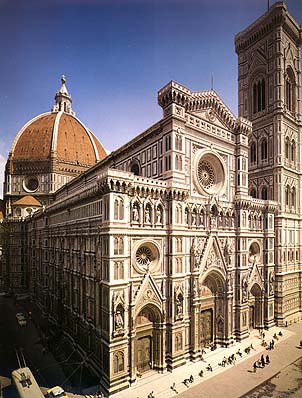
Dante above all, who was banned as victim of this party-quarrel, accompanies us to his quarter between Via del Corso and Piazza Signoria. His family, the Aligheri, owned some houses here. In the small church of San Martino he married Gemma Donati. The house of Beatrice Portinari - his immortal Beatrice - stood on the Corso, now Palazzo Salviati. When you enter this house to change money, a statue remembers you that Cosimo I spent his youth here...
In this town of history I'm feeling often more familiar than in present times.
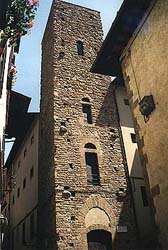
But for now there’s the church Santa Croce by sunset. The people say if
you want a photograph you have to go at sunset. Otherwise the sun is
behind it and you will never get a picture of it. The people are right.
A deep blue sky is beaming over the wide place - simply azzurro. On
two days in summer the Florentine youths are playing a sort of football
here in old costumes of the middle ages. It’s a pretty rough and brutal
sport but they still like it. The church stands at the end of
this place. The setting sun hits the white marble, the green serpentine
and red porphyry; the doves, teens and tourists are having it for
themselves and the Florentines meet for a chat.
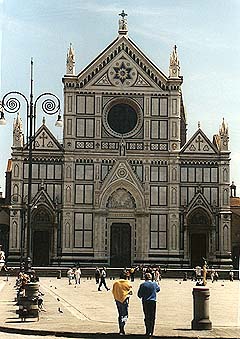
Santa Croce has traditionally always been used for important civic and
religious events because it is large enough to contain crowds of people.
This is where the Franciscan preachers, as well as St. Bernardino of
Siena, during the plague of 1437, addressed the population. This was
also where Carnival and May Day festivities were celebrated, as well
as tournaments, jousting and carousels, especially during the
Renaissance, with the enthusiastic partecipation of the younger
members of the Florentine aristocracy: such events included the
famous jousts described by Pulci (1469) and Poliziano (1475), with
Lorenzo and Giuliano de' Medici among the principal protagonists.
The Basilica of Santa Croce dominates the entire square. Constructed
between 1295 and 1443 on the site of an earlier and smaller Franciscan
oratory, built in around 1225-26, when the Saint was still alive, it
was subsequently enlarged in 1252. Arnolfo di Cambio, the brilliant
head architect of the City Council was entrusted with the new project
and, almost immediately afterwards, the city also commissioned him
to construct the new Cathedral and Palazzo della Signoria.

On the left side from the church Dante Alighieri is looking at us
with his "Divine Comedy" in hand - a late monument for the expelled
son of the town. His family didn’t belong to the emperor-faithful
(and thus enemies of the Pope) Ghibellinis. When the tide had turned,
he had to leave the town, in absentia sentenced to death and didn’t
see his beloved Florence ever again. Well, even then the right ‘book
of party’ was necessary for survival. Today Florence sends
oil for the lamps upon his grave in Ravenna each anniversary of his death.
Inside darkness and coolness are ruling. And there’s Michelangelo’s
grave, just right from the entrance. It never looked so gigantic in
photos. Three marble personifications of "sculpture", "painting" and
"poetry" surround his sarcophagus. The three things Michelangelo
had controlled to perfection.
His friend and adorer Giorgio Vasari did his job well to regard highly
the greatest of great artists. Vasari - also his biographer - not only
knew him very well, he loved him and - because he was artist
himself - he understood him completely: Michelangelo’s terribilit`a.
He always had been a victim of his own character, his talent, his
ingeniousness. But where had he received this genius from? Perhaps
we’ll find out here.
Actually the Romans and the pope wanted to have him buried in Rome
but his nephew remembered his wish to be buried in Florence. He stole
the dead body one stormy night and rode with him upon his horse the
long way from Rome to Florence. At least so the legend goes.
We are passing the cenotaph for Leonardo, passing the graves of
Machiavelli, Rossini and Galileo Galilei. After his inquisition
trial in Rome, Galileo was placed under house arrest, but he was
at least allowed to continue his studies. After his death in 1642 Grand
Duke Ferdinando de' Medici wanted to place a monument here over his
grave. But Pope Urban VIII warned the Duke for Galileo had
stubbornly defended his thesis that was opposed to the Holy Bible.
Therefore he would take each monument for the astronomer as a
personal offence against his authority. Well... Ferdinando wasn’t
brave enough to resist the pope and so it came that the body of the greatest
scientist of his time lay unburied for almost 100
years (well, in a coffin I assume) in a cellar under the clock tower
of Santa Croce. Only in November 1992, exactly 350 years after his death,
Galileo was openly rehabilitated by Pope John Paul II.
This church has important and imposing small chapels that are like a
string of pearls. Each noble family wanted to have its own, for instance
also the Rucellai, the family of Michelangelo's mother.
Evening falls when we are in the direction of the Uffizi Gallery.
Above our heads leads the corridor of Vasari, it is a sort of secret way, that
leads from Palazzo Vecchio (the town hall) over Ponte Vecchio to
Pitti-Palace, the place of the Medici-dukes of Toscana. The Uffizi-yard
is broad and empty until it is actually besieged by tourists who
desire entrance to the museum. But there it is: under the Loggia -
Cellini’s Perseus, lifting the head of Medusa high in the air,
triumphantly, naked and bronzed. Not far away from it, naked, firm
marble buttocks are held toward us. As a gay man you have come to the
right place it seems ;-) It belongs to a group of men that raid
women from the tribe of the Sabin, an old legend that belongs to
Rome. If you want to learn more about Cellini and the excitingly
work of "Perseus", just click
here.
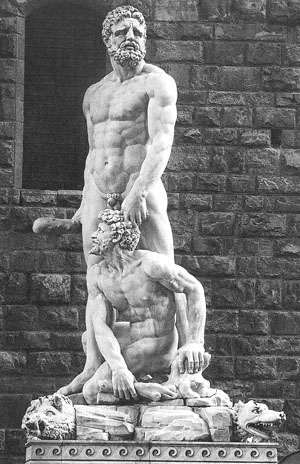
In front of the entrance to Palazzo Vecchio - this monstrous building
that stands tall above our heads in the warm light of lanterns - "David"
is waiting. Verdigris covered, but beautiful. And the difference between
copy and original we will see later.
Right beside stands the ungainly figure-group by
Baccio
Bandinelli.
"Cacus and Hercules". Cacus was a gigantic, murderous monster, a son
of Vulcanus, the blacksmith God, who was fought by Hercules finally.
This group was compared to "David" as an object of surreptitious
laughing. Cellini called it a "Melon squeezer". Poor Bandinelli.
Well, it wasn t that easy for Michelangelos contemporaries. It wasn’t
easy to outdo "David". Michelangelo's flexing of muscles and proportions
of the male body were perfect. And everything that came afterwards,
was grossly exaggerated. You know, sort of "Mister Universum".
Nonetheless the citizens left the figure standing where it was:
right beside the entrance to town hall, to protect the senate and
to protect the town. And as a warning: Florence was a free state,
independent from the pope and everybody that dared to attack it would
get it like Goliath from David. Like the Jew woman Judith did with the
conquerer Holofernes, like Perseus did with Medusa....
You can enter the inner yard of the town hall without problem. There's
a cute putto-spring in the center of it made by Verrocchio - who was
the teacher of Leonardo da Vinci. Formerly the putto had spun around
himself with water power, a dolphin lovingly pressed to his cheek,
but now it doesn’t anymore. The square, supported by golden pillars
is completely decorated with frescos.
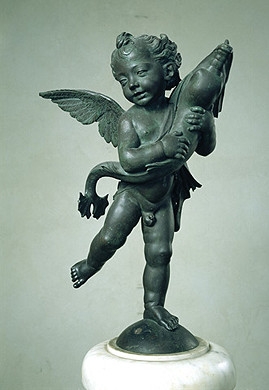
To celebrate the marriage of Francesco I de Medici with the Habsburg
princess Johanna of Austria the yard was painted with towns of the
Habsburg Reich like Prague, Passau, Graz, Freiburg, Linz, Bratislava,
Vienna, Innsbruck, Konstanz, etc. etc.
The rooms of the town hall can be visited and shouldn’t be missed.
They are mostly painted by Giorgio Vasari, but there are some fine
sculptures too, like the "Victory" by Michelangelo and some other
famous Renaissance-artists.
The most interesting tale happened there when Leonardo and Michelangelo
started a competition. In 1504 both had got the order to paint the Room of
the five hundred where the Senate of Florence (signoria) gathers. Both started
their work: Leonardo decided to portray the "Battle of Anghiari" (see picture
below), Michelangelo for the "Battle of Cascina".
Michelangelo proceeds well, but Leonardo - all self-confident fop and always up to
try out new things - tried a wax technique. For this, a fire has to be
lit to make the wax soft but since the fire was too hot on the lower side of the
fresco, the wax melted and the colours ran down, leaving long, tough traces down
and the fresco was destroyed.
Michelangelo said nothing, no triumph, no anything
although both weren’t exactly what we would call friends. Leonardo
simply went away and got busy with other things. The painting he had
forgotten instantly. And also Michelangelo never finished his fresco
because he was called to Rome to work for pope Julius II.
Careful examinations hasn't found any traces of it. Later it was Giorgio
Vasari who painted finally the room with huge freschi of battles. Of
Michelangelo's freschi there is just a cartoon left made by Aristotele da
Sangallo (1542) and is situated in Norfolk. Click here to see a sketch of
Michelangelo:

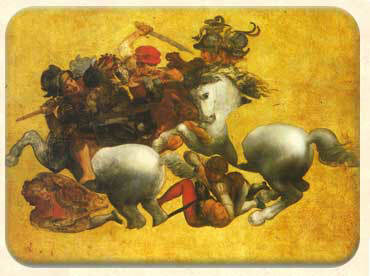
Outside again there is the large spring, the Florentine call "Biancone" -
the not beloved "big white one". It is the Neptune-fountain by
Ammannati who is similary unsuccessful like "Cacus and Hercules"
by Bandinelli. The spoiled Florentine mocked it as always.
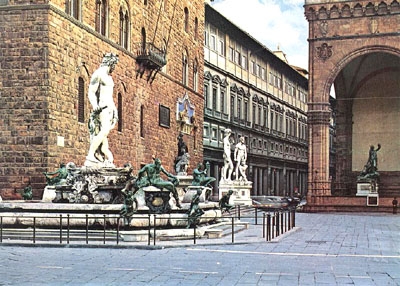
When you cross the Piazza Signoria you reach the large shopping mall
of Florence: the Via Calzaiouli. Ragazzi and tourists are mingling,
saunter up and down, from the cathedral to town hall and vice versa.
In the night you just can guess the big dimensions of the cathedral
and in front of the baptistery people stand and admire the
"Golden Gates of Paradise" made by Lorenzo Ghiberti. There’s the
tale of Brunelleschi and his friend Donatello, both had applied for
the contest of making the doors to the baptistery. Finally Ghiberti
won. Brunelleschi and Donatello went to Rome to study there the
antique monuments and to dig the Forum Romanum (yeah, they were sort
of predecessor of Sebastian von Scheffel ;-) The uneducated Roman
seemed to both Florentines very suspect because they thought they would
dig for gold (And probably both had been seen in indecent establishments
for gay customers). Until very much later the Romans also got the idea
to dig there, what gave the push for the excavations to the antique
Forums of the emperors.
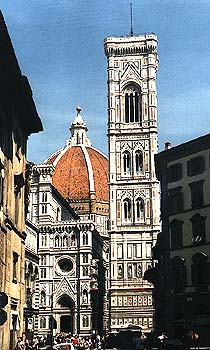
Brunelleschi arrived in Florence again just in time. The architects of
the duomo had the very difficult task of finishing the building with a
cupola. But they didn’t know how. Well, good old Brunelleschi thought
he had the solution. In presence of the signoria, the Senate of
Florence, he presented his proposal in demonstrating a standing egg.
You know, the "egg of Columbus" was actually the "egg of Brunelleschi".
He hit the egg upon the table and it stood. The model of his cupola
was daring. So daring that everybody was laughing. The space was so
big that it seemed to be impossible to close it. But Brunelleschi -
as we know - had studied Rome’s antique monuments, so the Pantheon,
which built a perfect circle in a cube. So Brunelleschi changed his
model to an egg-formed cupola that was erected within sixteen
years. It is the biggest self-carrying cupola of a Christian church.
Not even Saint Peter in Rome achieves its dimension. Remember it was
built without having cranes, without cement machines, without computer
animation or -calculation. Some scientists today are saying, the artists
of the time of the Renaissance had found the gate to macrocosm - in
their minds of course. All their thoughts are hovering in the
endless depths of the rooms. Matter can't disperse. But probably
it was just earth shaking compared to the gloomy area of the Middle
Ages.
If you need more information about the duomo I recommend reading
this.
Right beside the duomo is the bell tower of Santa Maria del Fiore, one of the most
beautiful in Italy, was an (extremely costly) invention of genius by Giotto which was
created more as a decorative monument than a functional one. In 1334 the great
artist started when work on it had already been interrupted for over
thirty years, while Arnolfo di Cambio worked for the Cathedral. Giotto
preferred to create something of his very own: the bell tower.
The artist worked from 1334 to 1337, the year of his death, on the
addition of the new architectural element that was to enrich the square, but only
lived to see the first floor of his project completed, where the pointed
entrance stands. White marble from Carrara, green marble from Prato and
red marble from Siena colour the surface (which today are the national
colours) while also dividing it up with classical rigor; a figurative
"narrative" (an indispensable form of expression for a painter) runs
around all four sides, carried out with a series of octagonal tiles
in relief by Andrea Pisano (who completed the South Doors of the
Baptistery in 1336) from designs that were carried out in part by
Giotto himself.
There are statues made by Donatello (you remember the friend of
Brunelleschi, the builder of the cupola). Formerly they stood as
decoration for the bell tower but of course they were too precious
to rot in sour rain and fumes. Once his figure of "Habakkuk" was
finished, Donatello stood in front of the very livid looking old
Prophet and cried out "Favella! Favella! Talk!!! Or the plague
should get you!"
But let me tell you something about Giotto. It started on a day in 1266.
On this day Giotto di Bondone was born. He was a shepherd's boy who
flabbergasted the old Master Cimabue while he was drawing a perfect
circle in Tuscany sand, there, out on the fields. Cimabue (who had
himself great merits as painter) gave Giotto an apprenticeship. You
know, in Giotto's time all churches were white washed, the old
freschi and mosaics removed and over painted. Why? Because the people
remembered the words of the New Testament: "You shouldn't make a
picture of myself." Well, somehow the old Greeks got bored with the
white churches and started to paint their monasteries again but
they had forgotten how to paint. When you match freschi, mosaics
and sculptures from ancient times with the time of the early middle
ages, your hair stays on end. It was as if they had been blind.
They couldn't work stone, no clue about perspective. But Giotto
sat among his sheep and drew from nature. Later he worked in
Padua, Rome, Assisi and of course Florence.
For instance he painted several chapels of Santa Croce with themes
of the life and death of Holy Francis.
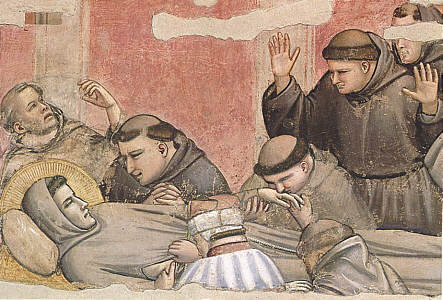
Well... I don't know why he didn't have any pupils or perhaps they
had been that bad that nobody could compare with Giotto's genius.
Anyhow, again it took one hundred years before another Giotto was
born, exactly here in Florence: Tommaso di Giovanni di Simone Guidi,
called Masaccio.
He studied Giotto's freschi in Santa Croce and quickly learnt to
continue his work and even more: He was the real new man who
remembered the perspective painting. His outstanding freschi in
the Brancacci-chapel of the Carmine-church were a never ending
source for studies. Michelangelo learnt the perspective
painting there, but more about this later.
Unfortunately Masaccio - wild and gay - died an early death in Rome
only 27 years old. He hadn't had time enough but what he did was
earth shaking enough to start a new era. The time of the Rinascimento
was born, the time of the neo-antique, the time of remembering the
Greek and Roman masters.
Back to the "Biancone". In front of it there’s a porphyry plate
inserted to the ground. It tells us that exactly at this place - for
about 500 years - Savonarola was burnt to ashes. Four years before
his death he burnt his "pyre of vanities". He was the Prior of the
church and Dominican monastery of San Marco and if you want to read
his story please click
here.
The whole of Florence knew that he was dying innocent, but breathed relieved -
freed from the urge to do good things. Michelangelo didn’t say a word
about the events in Florence. Although he does share a part of Savonarola’s
opinions, he condemned his fanaticism. Michelangelo was fanatic enough
himself to know what evil it brings.
Was it fair? The Florentines are still biased. Still they bring flowers
to this place on the day of his death.
Next morning is a fine opportunity to visit the granary. That’s a
church now, called "Orsanmichele" (actually San Michele in Orto,
because there once was a nunnery with a garden). This building had in
1350 a double function of the town granary and of an oratorium.
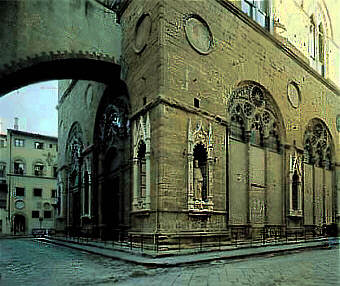
Arnolfo di Cambio had gotten the order to built an open hall,
to protect the merchants for rain and sun. But of course they had to
hang pictures of the Holy Michael and of the Madonna, as protection
from high above so to say. Well, the picture of the Madonna started
to work miracles and soon enough pious people were gathering to sing
"laudi" to honour the "Madonna of the Gracious". A brotherhood was
building. And soon later - after a fire - the still present, new
respresentative church was built while on the lower ground the
market was still open. The arcades were closed later with elaborated
Masswork of Florentine Gothic.
The most important things are the 14 recesses on the outer façade
because they were offered by the Parte Guelfa (the party of the pope)
to all guilds of the town to place there their patron saints. And so
it came that this building is today a precious museum itself, because
each of the rich guilds in town had engaged a famous artist.
I wonder how the town manages to protect these pieces of art against
destruction by modern vandals. I cannot imagine them standing in
Berlin or any other town in Germany without being smeared with
graffiti to say the least or in the worse case being completely
destroyed. Well... more on this theme later.
You can go inside of course. There’s a fantastic tabernacle made
by Orcagna for the miracle working picture of the Madonna. On the
ceiling are still hanging the old hooks for the sacks of grain.
Back to place of the huge cathedral. Yesterday night it was the
story of the cupola, but the interior is telling other stories.
Exciting ones. Although it is cold and empty because everything
that is precious has been brought to the museum of the cathedral,
like one of Michelangelo’s last pieta for instance.
The inside of the cupola is painted with freschi by Giorgio Vasari
again. But that’s not the interesting thing. It was in 1943 when the
Jewish people had to be deported from Florence. They remembered the
canteens and sleeping places Brunelleschi once had created for the
workers, so they didn’t have to walk two hours until they were down
and two hours up to reach the ceiling each morning and evening. The
places were still there and intact. They brought the Jews up there
and nobody ever found them there.
But there’s more exciting history: On Easter Sunday 1478 there took
place the so-called Pazzi conspiracy. Lorenzi il Magnifico de’ Medici
dragged himself seriously wounded into the sacristy while his beautiful,
not less popular brother Giuliano bled to death.
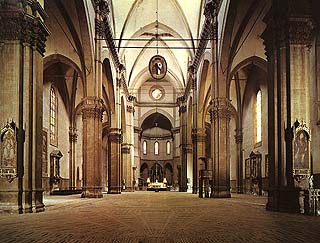
There it is, the pews that are positioned in a half round in front of the
altar. Here was sitting the noble people of the town, listenening to
the Easter-Mass. Slowly the priest lifting his arms in front of the the
altar. Just that moment there's a turmoil at the entrance. A splendid
dressed group is there, burst into the duomo, their heavy boots
scratching over stone.
A cry: "Prendi, traditore!" (Take this, traitor) and everybody is
frozen to the ground. A wild crying and screaming sounds from the
chancel, spreading out in the whole cathedral and sounding up to the
high cupola.
Bernardo Bandini pushes with all his might his short sword into
Giuliano's heart from behind. The young man falls and Franceschino
de'Pazzi pounces on him. Over and over again he stabs him with his
dagger, even when he's lying already motionless to the ground.
At the same time Maffei and Bagnone attack his brother Lorenzo.
But just one of their daggers hits and causes a deep flesh wound
in the neck. Lorenzo jumps over the balustrade, pulling his sword,
fighting, seeing a good friend dying for him beside him. He flees
through the chancel, passes the altar, into the sacristy where he
barricades himself with some of his friends. Blood is dripping on
bronze and marble.
Murder in a church! That’s an inexusable outrage, that pope Sixtus
IV had tacitly sanctioned. What had happened? Actually it was
just one another of the mad family feuds that so often happens in
Italy, until now. But the family of the Medici was something special.
Lorenzo de’ Medici as their ruling leader of town did exceptional
good things for the people and the country. But you know it: envious
persons are everywhere. The noble family of the Pazzi had enough to
leave the town's government
to any peasant's offspring of the Medici. Those parvenus! Just
the blood ennobles, they are saying, not the deeds. But nonetheless
the people of Florence had idolized Lorenzo's grandfather Cosimo, like
they do with Lorenzo himself, they knew themselves greatly protected
by the family of the Medici. But on Cosimo's grandson the revenge now
was executed. The Pazzi and their adherents found an ear even in
Rome, at the highest place with Pope Sixtus IV. He approved the attack,
because then he could spread the papal power even over Florence, the
heathen town, that so stubbornly insisted on being a republic and not
to belong to the Papal States. This conspiracy stretched even over the
archbishop of Florence: Salviati. Lorenzo and his beautiful brother
Giuliano had to die. A mercenary's army of Salviati waited in front of the
gates to the town, ready to overthrow the Signoria...
Well, the conspiracy failed. Lorenzo mourned his wonderful brother and
took terrible revenge. The Pazzi family had to suffer very hard. In the
yard of the Bargello - the police building - they had a fast trial and
next morning they were hung on the window crosses openly, also archbishop
Salviati, others banished for their lifetime.
Interested in more?

